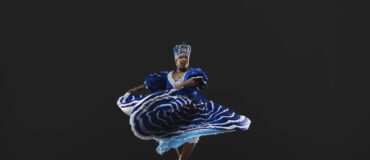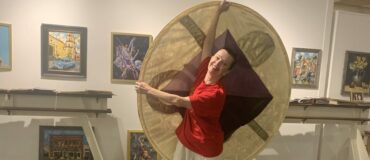By Sarah Nguyễn
Sarah Nguyễn was a 2020/21 Dance/USA Archiving & Preservation Fellow. Phase 1 of her Fellowship ran from June-September 2020, and was hosted remotely by AXIS Dance Company. For Phase 2 in the summer of 2021, Sarah continued her work with AXIS, remotely and on site. Read more about the Fellowship program here. This is the fourth and final part of Sarah’s blog; find the third part here.
Archives Meets Marketing
In this final blog post, among a short series about my experience collaborating with AXIS Dance Company to begin their dance preservation workflow journey, I will discuss my experience meeting the AXIS’ marketing and outreach department. These events also happened in August 2021, when there was a small window of time in which the world felt a little more open to meeting in-person again. See my previous blog post (Archives Meets People & Basement Storage) for a brief review of the excavation experience into the basement and storage units. In this post, I’ll touch upon pre-meeting organizing work, in-person hard drive organizing praxis, and the relationship that archives and marketing can forge to create a strong and sustainable bond for dance makers and companies.
Before I got to sunny Oakland, CA, I started to work with Danae, Octavia, Marc, and Judith to begin an inventory list of AXIS repertory. Here is a template of the inventory list for reference, which helped me communicate and collaborate with the Marketing team with common terms and understanding between the Archives and Marketing file management practices. This was eventually translated into the AXIS Asana company organization database tracker since that is their canonical collaborative tool as an active dance company. Based on the inventory list, I was able to work with Octavia to organize and create an accessible file naming convention for all new and old media (e.g. still and moving images) for social media, newsletters, website, performance footage, etc. As seen in the Records Management Manual, section 3: Preservation Notes, we came up with what would be most helpful in organizing and finding media files for current and future use. For example, most still and moving image files were renamed to follow a file naming template, such as:
YYYY_nameOfhomeSeason_workName_city_photogLName_##.jpg.
Each segment of the file name corresponds to data found in the inventory list. I will dive more into the collaboration between my work and Marketing towards the end of this blog post. First, I’ll address the surreal feeling of strolling through the halls of a commercial building, let alone an arts and culture institution which I’ve been recording, researching, and writing about for the past year.
Meeting Marketing
This brings us to the culminating moment when Archives meets Marketing, though all of the above work included relationship building and collaborating between archival and marketing materials. I finally got to meet Octavia after a few introductory calls and emails last summer. Octavia is the steadfast connoisseur of the intersection of dance, performance, and media for AXIS’ online presence, and they performed this with the modest tools of < 5 TB hard drives, Adobe Creative Cloud, Google Suite, and Dropbox. With Octavia, we explored the organization and operation of AXIS’ two online digital storage servers (Google and Dropbox), and set up back-ups, dark storage, and hard drive clean up.
Migrating and synchronizing AXIS’ Dropbox and Google Drive required a dedicated data organizer who filtered through Dropbox to create folders that mirrored each other between the two cloud servers, identify duplicate files, and move files into the appropriate folder hierarchies. This included reorganizing parent-level folders that identified departments, and sub-folders that sorted files by year, media type/file format, programming, work, etc. Mirroring folders is a term that indicates data (i.e. files and folders) are “copied, in its exact form, from one place to another in real-time. Data mirroring is implemented to ensure that your computing infrastructure is redundant. It’s a practice that is extensively used in Cloud Hosting” (Reseller Club, 2020). The Departmental Reference sheet from the Records Management Manual provides a visual breakdown on how we agreed to organize and mirror the two servers. Once the two servers were mirroring, we planned on mirroring Google Drive to Dropbox using Dropbox as an access-level back up. Google Drive would be the day-to-day access copies (version 1) which were backed up to Dropbox (version 2) in case Google was inaccessible at any point in time. From there, we discussed what it meant to set up a dark storage backup system. While the archival materials would be held in The Bancroft Library’s temperature controlled storage, this third level dark storage backup system would be for AXIS’ digital content should Google and Dropbox servers fail at any point in time. While I do not endorse any one particular data server, I recommended Backblaze since they are industry leaders and are most transparent on their storage practices in comparison to Google Cloud, Microsoft Azure, Amazon Web Services (Klein, 2021). I’m also somewhat biased in favor of the underdogs as opposed to big tech companies 🙃.
Meeting My Thoughts About Archives x Marketing
The Archives department is not the Marketing department, nor is it graphic design, video editing, or social media. However, in this Big Tech world of undervalued arts and cultural heritage organizations in which we are left to rely on precarious grant funding, our passions and vocational awe for creative works leads to wearing many hats. Archives and Marketing work are different, but there is much opportunity for these departments to work closely together to help any individual dancer, dance company, or creative collective to survive and thrive in our increasingly digital world.
Namely, for an active dance company seeking to survive and thrive during the COVID-19 pandemic, digging in their archives, digitizing historical records, and sharing these stories has proven to be a powerful way to share work with the community since coming together to create and rehearse has been difficult to manifest.
The Venn diagram (Figure 1) is not a comprehensive nor exclusive list of each department, but it illustrates the crossovers and distinctions between archives and marketing in their more well-known roles within organizations. Each department depends on the other, just as there is an overall dependency that the dance artists, teaching artists, production teams, and administrative teams share.

Figure 1: Venn diagram listing the similarities and differences between Archives and Marketing departments.
In the past 22 months, dancers and dance companies have relied on digital photos, videos, music, gifs, and contracts to continue creating, connecting, and sharing embodied expressions. This post is a reflection on my experience working with AXIS Dance Company’s “Marketing department.” But, let’s be realistic: like almost any dance company, regardless of how successful, I was collaborating with the overworked Executive Director and the sole (part-time) Marketing Manager to understand, organize, and figure out better operations of all media assets, all while they were dealing with changing COVID safety protocols; finances; outreach to audiences so that the company wouldn’t be forgotten; and mental, physical, and emotional support to their artists and dance community at large.
In my experience with AXIS, I was starting the archival process while the company was very active and alive in creating, sharing, and educating their community during the pandemic—archiving marketing material for active continued use. Like many other dance companies during the pandemic, AXIS started to dig into their archives for marketing materials and for recreating works. In this blog, I’m thinking about dance company digital asset managers who are usually double dipping as marketing managers and how they can incorporate archival practices into their daily workflow, and so I hope the resources and reflections I’ve shared are helpful.
Please feel free to reach out to me if you have any questions, thoughts, and/or comments about this process. (Contact Dance/USA’s archiving team, Imogen Smith and Hallie Chametzky, if you’d like to be in touch.) I’m happy to chat with any dancers, arts administrators, and others who are interested in creating workflows between outreach and preservation of their creative works.
 Sarah Nguyễn is a librarian-archivist in training and a movement practitioner. Their research interests include the ephemerality of dance, the obsolescence rate of digital creations, and the processes and ethics behind preservation, reproduction, and representation. As an advocate for open, accessible, and secure technologies, Sarah has fulfilled these values through projects such as Preserve This Podcast, Investigating & Archiving the Scholarly Git Experience, Mark Morris Dance Group Archive, CUNY City Tech Open Education Resources, and linkRot, an intermedia performance simulating the physical euphoria that internet content creation permits into the digital decay that comes with/out feelings of loss.
Sarah Nguyễn is a librarian-archivist in training and a movement practitioner. Their research interests include the ephemerality of dance, the obsolescence rate of digital creations, and the processes and ethics behind preservation, reproduction, and representation. As an advocate for open, accessible, and secure technologies, Sarah has fulfilled these values through projects such as Preserve This Podcast, Investigating & Archiving the Scholarly Git Experience, Mark Morris Dance Group Archive, CUNY City Tech Open Education Resources, and linkRot, an intermedia performance simulating the physical euphoria that internet content creation permits into the digital decay that comes with/out feelings of loss.
With AXIS Dance Company, Sarah is looking forward to bringing physically integrated dance, disability rights, and independent living movements to our cultural heritage legacy. The North Bay Area is Sarah’s hometown and they are excited to bridge recent experiences in archival practices with their lifelong dance practice to the community that inspired them to pursue dance preservation. Currently, Sarah is a PhD student at the University of Washington.
____
We accept submissions on topics relevant to the field: advocacy, artistic issues, arts policy, community building, development, employment, engagement, touring, and other topics that deal with the business of dance. We cannot publish criticism, single-company season announcements, and single-company or single artist profiles. Additionally, we welcome feedback on articles. If you have a topic that you would like to see addressed or feedback, please contact communications@danceusa.org.
Disclaimer: Opinions expressed in guest posts do not necessarily represent the viewpoints of Dance/USA.






